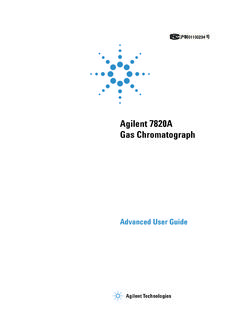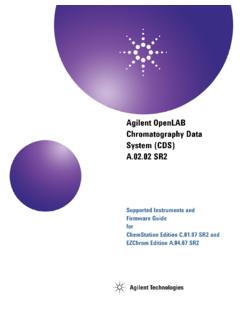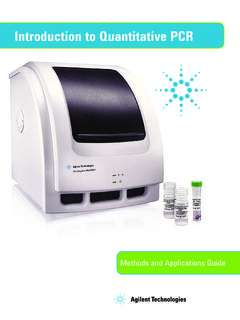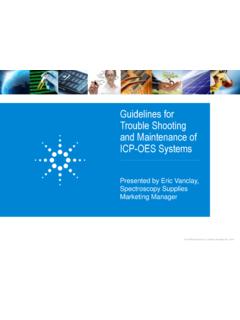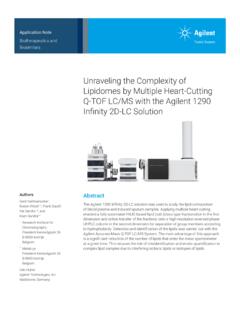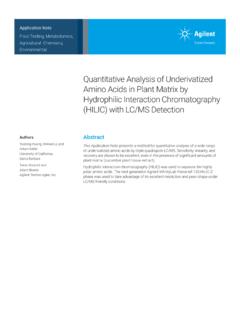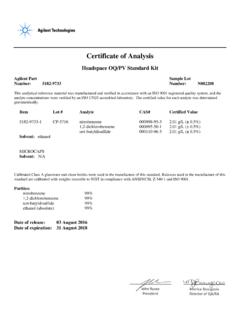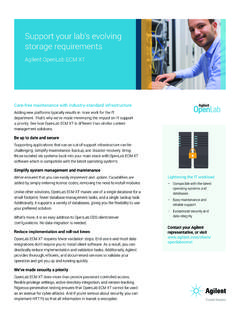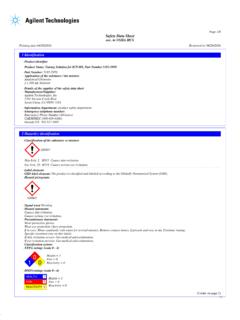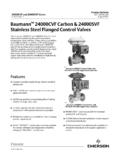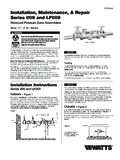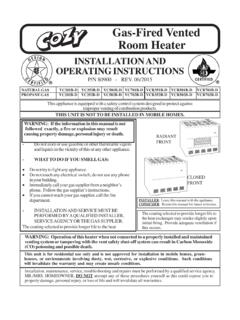Transcription of Agilent GC, GC/MS, and ALS
1 Agilent Technologies Agilent GC, GC/MS, and ALSSite Preparation Guide2GC, GC/MS, and ALS Site Preparation GuideNotices Agilent Technologies, Inc. 2017No part of this manual may be reproduced in any form or by any means (including elec-tronic storage and retrieval or translation into a foreign language) without prior agree-ment and written consent from Agilent Technologies, Inc. as governed by United States and international copyright Part NumberG3430-90038 EditionTwelfth edition, July 2017 Eleventh edition, April 2017 Tenth edition, June 2016 Ninth edition, August 2014 Eighth edition, January 2013 Seventh edition, February 2012 Sixth edition, February 2012 Fifth edition, November 2011 Fourth edition, July 2011 Third edition, November 2009 Second edition, September 2009 First edition, April 2009 Printed in USA or ChinaAgilent Technologies, Inc. 2850 Centerville Road Wilmington, DE 19808 USA 412 800 820 3278 AcknowledgmentsMicrosoft and Windows are registered trademarks of Microsoft and Pentium are registered trade-marks of Intel Corporation.
2 WarrantyThe material contained in this document is provided as is, and is subject to being changed, without notice, in future editions. Further, to the maximum extent permitted by applicable law, Agilent disclaims all warranties, either express or implied, with regard to this manual and any information contained herein, including but not limited to the implied warranties of merchantability and fitness for a particular purpose. Agilent shall not be liable for errors or for incidental or consequential damages in connection with the furnishing, use, or performance of this document or of any information contained herein. Should Agilent and the user have a separate written agreement with warranty terms covering the material in this document that conflict with these terms, the warranty terms in the separate agreement shall NoticesCAUTIONA CAUTION notice denotes a hazard. It calls attention to an operating procedure, practice, or the like that, if not correctly performed or adhered to, could result in damage to the product or loss of important data.
3 Do not proceed beyond a CAUTION notice until the indicated conditions are fully understood and met. WARNINGA WARNING notice denotes a hazard. It calls attention to an operating procedure, practice, or the like that, if not correctly performed or adhered to, could result in personal injury or death. Do not proceed beyond a WARNING notice until the indicated conditions are fully understood and met. GC, GC/MS, and ALS Site Preparation Guide3 Contents17890 Series GC Site PreparationCustomer Responsibilities 8 installation Kits 9 Hydrogen Gas 11 Dimensions and Weight 12 Power Consumption 19 USA fast heating oven, 240 V 21 Canadian installation 21 Common instrument power cord plugs 22 Heat Dissipation 24 Exhaust Venting 25 Hot air 25 Other gases 26 Exhaust vent fittings 27 Environmental Conditions 28 Gas and Reagent Selection 30 Gas and Reagent Purity 34 Gas Supplies 35 General requirements 35 Hydrogen supply requirements for carrier gas and JetClean systems 37GC/MS Gas and Reagent Requirements 38 Gas Plumbing 43 Supply tubing for most carrier and detector gases 44 Supply tubing for hydrogen gas 45 Two-stage pressure regulators 46 Pressure regulator-gas supply tubing connections 46 Filters and traps 47 Cryogenic Cooling Requirements 52 Using carbon dioxide 52 4GC, GC/MS.
4 And ALS Site Preparation GuideUsing liquid nitrogen 54 Using compressed air 55 Maximum Length of Cables and Hoses 56 Site LAN Network 57PC Requirements 5926850 Series GC Site PreparationCustomer Responsibilities 62 Basic Tools and installation Kits 63 Hydrogen Carrier Gas 69 Dimensions and Weight 70 Power Consumption 73 Canadian installation 75 Common instrument power cord plugs 75 Heat Dissipation 78 Exhaust Venting 79 Environmental Conditions 80 Gas Selection 81 Gas and Reagent Purity 84 Gas Supplies 85 Requirements for hydrogen as a carrier gas 86GC/MS Gas Requirements 87 Gas Plumbing 89 Supply tubing for most carrier and detector gases 90 Supply tubing for hydrogen gas 91 Two-stage pressure regulators 92 Pressure regulator-gas supply tubing connections 92 Filters and traps 93 Cryogenic Cooling Requirements 98 Using carbon dioxide 98 Maximum Length of Cables 100 GC, GC/MS.
5 And ALS Site Preparation Guide5 Site LAN Network 101PC Requirements 10237820 MSD Site PreparationCustomer Responsibilities 104 Site Preparation Good Practices 104 Agilent Technologies installation and Familiarization Services 105 Basic Tools and Consumable Supplies 106 Dimensions and Weight 108 Power Consumption 110 Grounding 111 Canadian installation 112 Common instrument power cord plugs 112 Heat Dissipation 115 Exhaust Venting 116 Hot air 116 Other gases 116 Exhaust vent fittings 117 Environmental Conditions 118 Gas and Reagent Selection 119 Gas and Reagent Purity 120 Gas Supplies 121 General requirements 121 Requirements for hydrogen as a carrier gas 122GC/MS Gas and Reagent Requirements 123 Gas Plumbing 125 Supply tubing for most carrier and detector gases 126 Supply tubing for hydrogen gas 127 Two-stage pressure regulators 128 Pressure regulator-gas supply tubing connections 128 Filters and traps 129 6GC, GC/MS, and ALS Site Preparation GuideMaximum Length of Cables 134 Site LAN Network 135PC Requirements 13647693A and 7650 Automatic Liquid Sampler Site PreparationCustomer Responsibilities 138 Basic Tools and Consumable Supplies 139 Dimensions and Weight 140 Power Consumption 141 Environmental Conditions 141 Chiller Supplies 1427GC, GC/MS.
6 And ALSSite Preparation GuideAgilent Technologies17890 Series GC Site PreparationCustomer Responsibilities 8 installation Kits 9 Hydrogen Gas 11 Dimensions and Weight 12 Power Consumption 19 Heat Dissipation 24 Exhaust Venting 25 Environmental Conditions 28 Gas and Reagent Selection 30 Gas and Reagent Purity 34 Gas Supplies 35GC/MS Gas and Reagent Requirements 38 Gas Plumbing 43 Cryogenic Cooling Requirements 52 Maximum Length of Cables and Hoses 56 Site LAN Network 57PC Requirements 59 This section outlines the space and resource requirements for GC, GC/MS, and automatic liquid sampler (ALS) installation . For a successful and timely installation of the instrument, the site must meet these requirements before beginning installation . Necessary supplies (gases, tubing, operating supplies, consumables, and other usage-dependent items such as columns, vials, syringes, and solvents) must also be available.
7 Note that performance verification requires the use of helium carrier gas. For MS systems using chemical ionization, methane reagent gas or methanol (for internal ionization ion traps) is also required for performance verification. Refer to the Agilent Web site at for the most up-to-date listing of GC, GC/MS, and ALS supplies and 7697A Headspace Sampler site prep specifications, refer to the 7697A Site Prep Series GC Site Preparation 8GC, GC/MS, and ALS Site Preparation GuideCustomer ResponsibilitiesThe specifications in this manual outline the necessary space, electrical outlets, gases, tubing, operating supplies, consumables, and other usage-dependent items such as columns, vials, syringes, and solvents required for the successful installation of instruments and systems. If Agilent is delivering installation and familiarization services, users of the instrument should be present throughout these services; otherwise, they will miss important operational, maintenance, and safety Agilent is delivering installation and familiarization services, delays due to inadequate site preparation could cause loss of instrument use during the warranty period.
8 In extreme cases, Agilent Technologies may ask to be reimbursed for the additional time required to complete the installation . Agilent Technologies provides service during the warranty period and under maintenance agreements only if the specified site requirements are Series GC Site Preparation GC, GC/MS, and ALS Site Preparation Guide9 installation KitsAgilent offers several installation kits that provide parts useful during GC installation . These kits are not supplied with the instrument. Agilent highly recommends these kits if you did not order the pre-plumbed option 305. These kits include tools and hardware required to plumb gases to the GC. Ta b l e 1 installation kits KitPart numberKit contentsRecommended for FID, NPD, FPD:GC Supply Gas installation Kit with Gas Purifiers19199 NIncludes Gas Clean Filter system kit CP736538 (with 1 oxygen, 1 moisture, and 2 charcoal filters), 1/8-inch brass nuts and ferrules, copper tubing, 1/8-inch brass tees, tubing cutter, 1/8-inch brass caps, universal external split vent trap with replacement cartridges, and 1/8-inch ball valve7890 Series GC Site Preparation 10GC, GC/MS, and ALS Site Preparation GuideYou must also provide the fittings and reducers required to convert the cylinder regulator fitting (for example, 1/4-inch male NPT) to the 1/8-inch female Swagelok fitting needed to connect to the instrument.
9 These fittings are not included with the GC. These fittings are not included with the installation kits. See Gas Plumbing on page 43 for part for TCD/ECD, MS, and MSD:GC Supply Gas installation Kit19199 MIncludes 1/8-inch brass nuts and ferrules (20), copper tubing, 1/8-inch brass tees, tubing cutter, 1/8-inch brass caps, 7-mm nut driver, T-10 Torx driver, T-20 Torx driver, 4 open-end wrenches, and 1/8-inch ball valve(For TCD/ECD, also order an additional Gas Clean Filter CP17974.)Gas Clean Filter kit GC-MS 1/8in.,1/pkCP17974 Gas Clean filter kit with 1/8-inch fittings (order 2 if using separate makeup and carrier gas supplies).Ta b l e 1 installation kits (continued)KitPart numberKit contents7890 Series GC Site Preparation GC, GC/MS, and ALS Site Preparation Guide11 Hydrogen GasIf planning to use hydrogen as a carrier gas or for the JetClean ion source system, note that special considerations apply due to hydrogen s flammability and chromatographic properties.
10 Agilent highly recommends the G3388B Leak Detector to safely check for leaks. Hydrogen gas requires special considerations for supply tubing. See Gas Plumbing on page 43 and Supply tubing for hydrogen gas on page 45. In addition to the supply pressure requirements listed in Gas Supplies on page 35, Agilent also recommends users of hydrogen supplies for carrier gas or the JetClean ion source system, consider the gas source and purification needs. See the additional recommendations in Hydrogen supply requirements for carrier gas and JetClean systems on page 37. When using hydrogen carrier gas with a ECD, TCD, MS, or any other detector that vents uncombusted gases, plan to vent the detector or foreline pump output to a fume hood or similar location. Uncombusted hydrogen can present a safety hazard. See Exhaust Venting on page 25. When using hydrogen carrier gas, also plan to safely vent inlet split vent flows and purge vent flows.
